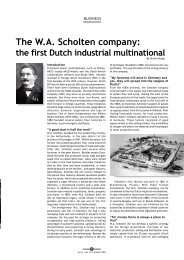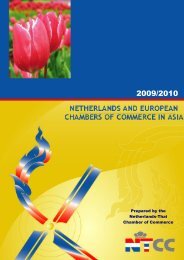October - November 2012 - Association of Dutch Businessmen
October - November 2012 - Association of Dutch Businessmen
October - November 2012 - Association of Dutch Businessmen
Create successful ePaper yourself
Turn your PDF publications into a flip-book with our unique Google optimized e-Paper software.
Business<br />
Sustainability & Business: China<br />
Text Petra Pronk<br />
If you look out <strong>of</strong> your hotel room window, if you are lucky<br />
enough to get one, the Red Dragon is bathed in different<br />
shades <strong>of</strong> green and grey light in the early morning. As the<br />
biggest coal economy in the world, this colour scheme is<br />
not likely to change very quickly. At the same time China<br />
is <strong>of</strong>ten mentioned in relationship to renewable energy,<br />
sustainable growth, etc. As the second largest economy, it<br />
would be a major win if China could take a lead towards a<br />
sustainable and more responsible future. Is China ready to<br />
take on that challenge?<br />
Economy<br />
China’s growth has been remarkable in many ways. During<br />
the first 4 phases <strong>of</strong> modernisation, between 1980 and<br />
2000, this Red Dragon succeeded in keeping growing<br />
energy demands at half the pace <strong>of</strong> their economic growth.<br />
Most developing countries have their economies grow<br />
in a one-to-one correlation with energy consumption.<br />
Currently, however, this trend has been reversed in China<br />
and the growth in energy demand is 1.4 times the rate <strong>of</strong><br />
the economic growth. By 2020, China intends to quadruple<br />
its economy, which means that it will be the size <strong>of</strong> 3 more<br />
Chinas by the end <strong>of</strong> that year. Without major government<br />
intervention, China’s energy sector will be increasingly<br />
dominated by the cheapest and easily available resources,<br />
coal and oil. They are only cheap if health, safety and<br />
environmental costs are ignored.<br />
Connecting the Dots<br />
The biggest challenge for China to ensure sustainable<br />
growth is to connect the dots between economy and<br />
ecology; between economic growth and environmental<br />
costs. China’s challenge encompasses more than solar<br />
panels, hybrid cars, wind turbines, carbon trade and green<br />
buildings. From the outside looking in, it seems like a<br />
paradox. Reports on major health and safety issues such as<br />
air pollution, dirty factories and man-made droughts and<br />
floods are all too familiar. At the same time, it is a startling<br />
realisation that world’s biggest carbon polluter has lifted<br />
400 million people from poverty since the 1980s, has 690<br />
million people living in cities and an economy that grows<br />
by 7% each year.<br />
The world expects China to continue its growth in a<br />
sustainable way. We are depending on China to get it right<br />
the first time!<br />
Coal Using Nation<br />
One <strong>of</strong> the biggest challenges lies in the fact that China is<br />
the world’s most coal dependent economy. It uses more<br />
than the USA, Europe and Japan combined. As it sits on<br />
the world’s third largest coal reserve, it is very attractive to<br />
continue to use coal. However, this would be disastrous for<br />
China, but also for the rest <strong>of</strong> the world. Although China’s<br />
focus is on economic growth, the government has come to<br />
the realisation that it needs to link the dots between the<br />
economic growth and the environmental challenges.<br />
With coal providing over 2/3rds <strong>of</strong> China’s electricity<br />
needs, power stations have been opening at a rate <strong>of</strong> one<br />
a week. They recently opened their first self-developed,<br />
Integrated Gasification Combined Cycle (IGCC) power<br />
station. This is a far cleaner and more efficient way to<br />
use coal, as it produces only 1/10th <strong>of</strong> the usual carbon<br />
emissions. In this facility in Tianjin, tonnes <strong>of</strong> CO2<br />
production is being sold, at a pr<strong>of</strong>it, to a local beverage<br />
company to make fizzy drinks. However, the majority <strong>of</strong><br />
the CO2 produced is planned to be used to sequester in<br />
<strong>of</strong>f shore oil wells to help oil recovery. China may lead in<br />
carbon capture technology in some areas <strong>of</strong> the country,<br />
but this doesn’t mean that CO2 is always put to good use.<br />
At a new facility in Shanghai, production far exceeds the<br />
needs <strong>of</strong> other industries, so the rest <strong>of</strong> the CO2 is simply<br />
released into the atmosphere.<br />
This dualistic approach to dealing with coal dependency<br />
and its effects is also in evidence at that world’s largest<br />
8















